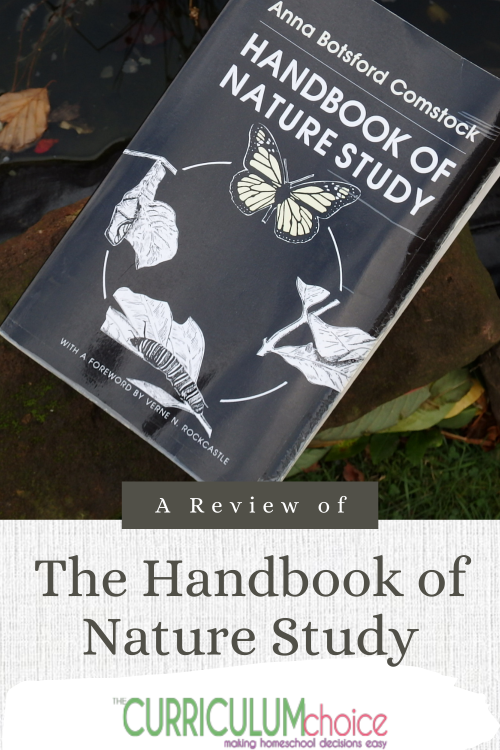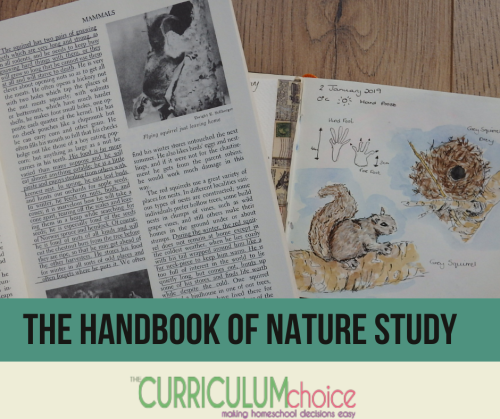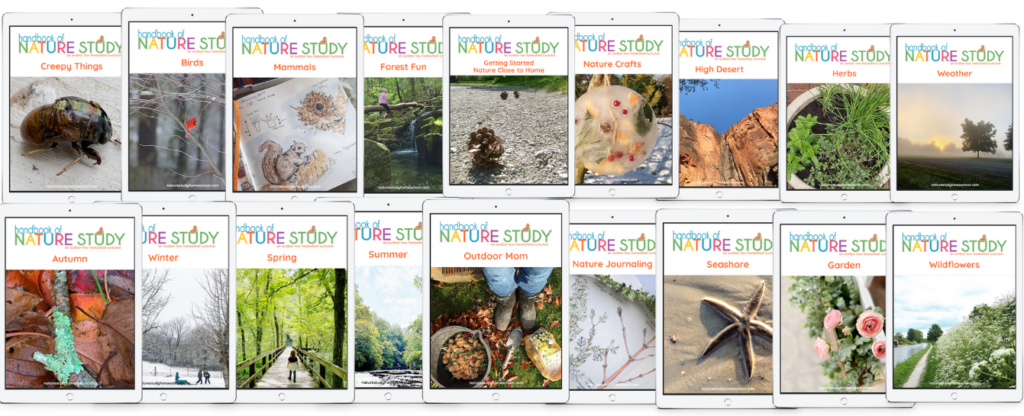The Handbook of Nature Study has become my best friend. It hasn’t always been that way. In fact, I purchased it, could not figure out how to use it, and promptly sold it to a fellow homeschooler.
I thought about this book from time to time as other homeschoolers would write about it on their blog or I would see it mentioned in nature study groups to which I belonged.
“In nature-study the work begins with any plant or creature which chances to interest the pupil….Nature-study is for the comprehension of the individual life of the bird, insect, or plant that is nearest at hand.” Handbook of Nature Study, page 5

A few years later I took another crack at it using a copy from the library and this time I was determined to use this huge resource in our nature study plans.
I started at the beginning of the book and read through the foreword and then the preface. I tackled Part I of the book and suddenly it all clicked into place in my head. I had been trying to use this book as a field guide and that was not the purpose intended at all.
The Handbook of Nature Study Book was Written for Teachers, not Students!
Anna Botsford Comstock did not set out to write a really long book about nature study, rather it was written as a collection of leaflets published as part of the Home Nature-Study Course for teachers and were then compiled into one volume in the Handbook of Nature Study and published originally in 1911.
The lessons were written for teaches and not for young students and were intended to give the teacher an overview of a topic and then to give some suggestions for observation to use with the students.
Although written at the beginning of the 20th century, these nature lessons are still pertinent today and our family has used them to discover a wonderful world right outside our own back door.
The Handbook of Nature Study can give you years of nature study ideas and even though it is written with a focus on eastern United States subjects, it can easily be adapted and used in all parts of the United States, North America, and beyond.
I have seen it work worldwide in a variety of habitats by families that take the basic idea and apply it in their own way.
One Way to Use the Handbook of Nature Study
The Handbook of Nature Study can be used in a variety of ways. When we first started out we used the suggested nature study rotation from Ambleside Online which focuses on three aspects of nature per year.
For instance, you can choose to study mammals in autumn, birds in winter, and garden flowers in spring. Each week you pick a focus subject within the overall topic and read a little about it. Then using observation ideas given in the lesson, you can complete your nature study lesson using subjects you observe in person.
This worked very well for us and I know it has helped many families organize their nature study. If you choose to use this sort of schedule, make sure to read the introductory twenty-four pages in the Handbook of Nature Study before you get started with specific topics from the book and I always recommend underlining or highlighting thoughts that you want to incorporate into your family’s nature study.
The beauty of this system is that you can personalize your nature study to fit the interests of your family and spend as much or as little time on a topic.

The Outdoor Hour Challenges-Another Way to use the Handbook of Nature Study
As many of you know, I use the Handbook of Nature Study every week and share our plans and results using the Outdoor Hour Challenges.
The challenges were born when a blog reader suggested I lead a weekly nature study plan using the Handbook of Nature Study. That was nearly twelve years ago and we are still going strong, never running out of ways to include the information in the book with our weekly challenges.
If you want to know how to get started with the Outdoor Hour Challenges, you can follow this LINK.
How do the challenges use the Handbook of Nature Study?
- I suggest a few pages to read in the book before you take 10-15 minutes of outdoor time with your children.
- Each challenge gives you a focus but I always remind moms to be flexible and follow the child’s lead if something more interesting comes your way. You may be out looking for oak trees but a woodpecker decides to let itself be seen. By all means, observe the woodpecker!
- When you come indoors, take a few minutes to talk about what you saw during your nature study time outdoors.
- Use the Handbook of Nature Study, either the table of contents or the index, and look up more information to follow up a child’s interest.
- Make time for a nature journal entry if you desire. I encourage a sketch, a label, and a date. It is a simple as that…really.
- The Handbook of Nature Study can be used before your study as a way to prepare for your outdoor time and then again afterward as a follow-up for any particular interest.
I highly recommend this book and I believe it should be on every homeschoolers science shelf as a resource and inspiration.
The purchase of this book will give you years of topics to incorporate into your science and nature study plans. For younger children, the Handbook of Nature Study can provide the foundation of solid knowledge of the natural world. There is an online version available as a free download HERE.
“A teacher does not need to know much about nature to use this handbook. The information is there for the novice and the expert alike. All that is needed is an inquiring mind, senses to observe, and a willingness to think about nature on a personal level.” Handbook of Nature Study, foreword to the 1986 reissue.
More Handbook of Nature Study Book Help
Check out our sister site – Homeschool Nature Study for everything you need to use the Handbook of Nature Study and Outdoor Hour Challenges in your homeschool!

Additional blog entries you might like to read:
- Living Book Press Handbook of Nature Study
- How to Get Started with Nature Study
- Beginner’s Tips
- Getting Started with Nature Journaling in Your Homeschool
- Outdoor Hour Challenges – Handbook of Nature Study Review
Written by Barb-Harmony Art mom.

Many people do not know where to begin, but really WANT to do nature studies. This is an excellent post on just getting this wonderful resource and just doing it! I’m going to send it to my friends that have talked about doing nature studies, but I know are intimidated.
.-= Brenda´s last blog ..I finally finished it! My First E-book =-.
I know I had no idea where to begin when I decided to take on nature studies. I thought it was just about taking a walk and drawing a picture..lol. This is a great post to make the most out of nature outings and journals! I love the book and recommend it all the time.
.-= Richele´s last blog ..Book Review: GREEN =-.
I was wondering which edition of this book to purchase. Some of the reviewers at amazon.com mention that at least one of the editions has terrible pictures, but they do not specify which edition(s). Other reviewers rave about the “beautiful pictures”, but also do not specify which edition. My local bookstores don’t even carry a copy of this at all, so I am not able to look at a hard copy. Suggestions?
Hi Terri – Barb-Harmony Art Mom has shared everything you need to know about getting started with Handbook of Nature Study. Take a look at this post, especially in the right-hand sidebar she mentions details of the book. Plus much more: http://handbookofnaturestudy.blogspot.com/p/outdoor-hour-challenges.html
After reading the reviews on Amazon I too was leary of purchasing the book. Instead I went to google books and downloaded the free ebook version (https://play.google.com/store/books/details/Anna_Botsford_Comstock_Handbook_of_Nature_study_fo?id=OHoeAAAAMAAJ#?t=W251bGwsMSwyLDUwMSwiYm9vay1PSG9lQUFBQU1BQUoiXQ..). I’m reading it on my iPad using the Google Play app but you can also read it in your browser on the computer. My son is only 3 so we’re mainly at the “ooh look, a worm” stage but I can’t wait to start doing more involved nature studies.